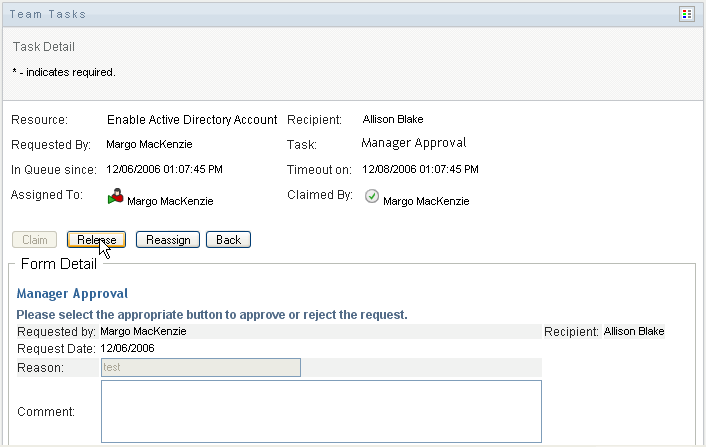12.2 Managing Your Team’s Tasks
When a task is in a workflow queue, you can perform the following actions:
12.2.1 Viewing Tasks by Team Member
A team manager can view a team member’s tasks. Only tasks available to the team can be listed in the task list.
-
Click in the group of actions to display the Team Tasks window.
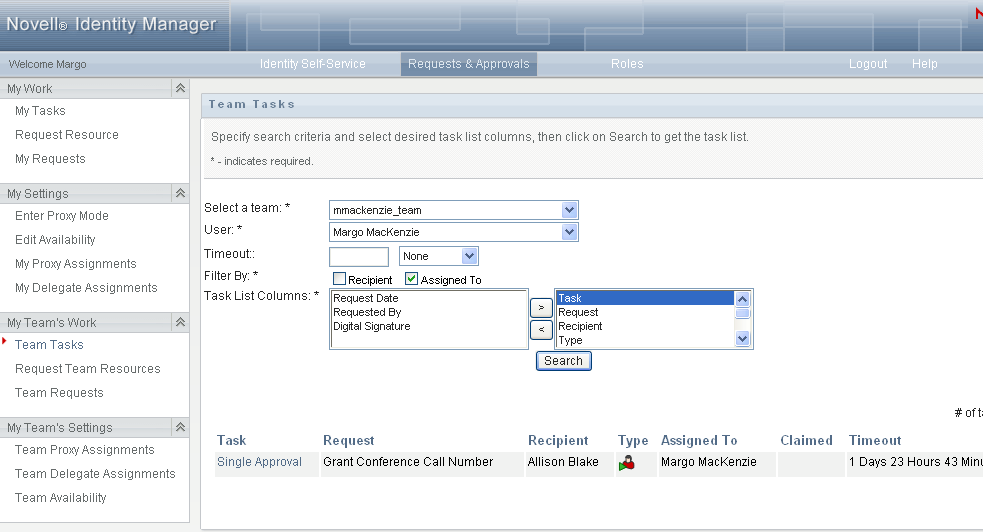
-
Click the down-arrow to display teams. Select a team for which you have been designated a team manager.
-
Select a user.
If the selection box contains a name, click the down-arrow to display all the members of the selected team. Click the name of the person whose tasks you want to display.
If the selection box is empty, click the icon to open the Object Lookup window. Specify search criteria for the team member, click and select the team member.
Your administrator defines your team and defines whether you see an automatically populated selection list or an empty list with an icon
 beside the selection box.
beside the selection box.
-
(Optional) Specify a interval to find tasks that expire within the time you select. Specify one or more digits, for example 10.
If you specify a interval, choose whether the interval is days, weeks, or months.
-
Use to select the subset of tasks you want to see for a team member. To see tasks that grant or revoke resources for the team member, select . To see tasks that the team member is responsible for doing, select . You can select both kinds of tasks.
-
In the selection box, select one or more task columns to display and click the right-arrow to add them to the task list. The order in which you select the columns is the order in which they appear in the display. Columns can include:
- Task. (Required.)
- Request
- Recipient
- Request Date
- Type
- Assigned to
- Requested by
- Claimed
- Timeout
- Priority
- Digital Signature
-
Click to list the selected user’s tasks.
-
To see another team member’s tasks, or tasks for another team, return to Step 2 and define a new search.
12.2.2 Viewing Tasks by User or Group
A Provisioning Application Administrator can view tasks by user or group.
-
Click in the group of actions to display the Team Tasks window.
-
For , choose or .
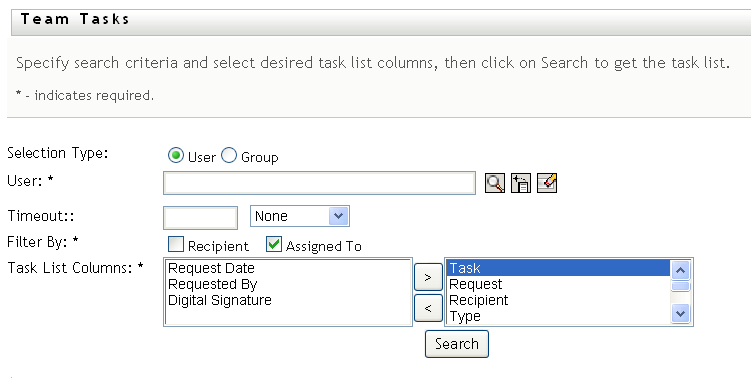
-
To look up a name, click the icon
 , specify lookup criteria, and click
.
, specify lookup criteria, and click
.
Click a user name or group name to select it. The following sample of the object lookup page was a lookup of all groups:
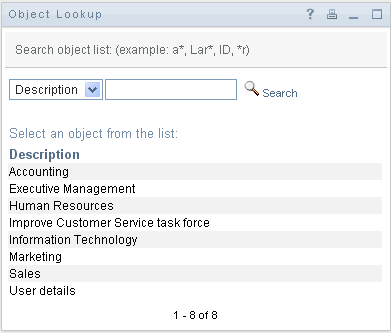
-
Optionally, specify a Timeout interval to find tasks that expire within the interval. Specify one or more digits.
If you specify a interval, choose whether the interval is days, weeks, or months.
-
Use to select a subset of tasks. To see tasks that grant or revoke resources to the user or group, select . To see tasks that the user or group is responsible for doing, select . You can select both kinds of tasks.
-
In the selection box, select one or more task descriptions to display, then click the right-arrow to add the descriptions to the task list. The order in which you add the descriptions is the order in which they appear as column headers in the task list. Your choices are:
- Task. (Required.)
- Request
- Recipient
- Request Date
- Type
- Assigned to
- Requested by
- Claimed
- Timeout
- Priority
- Digital Signature
-
Click to display the tasks.
Group tasks displayed are those explicitly assigned to the group, not those assigned to each member of the group. To see tasks assigned to an individual, view the tasks for that person.
-
To see tasks for another user or group, return to Step 2 and define a new search.
12.2.3 Using the Task Displays
The task list appears in the Template Display or the Exhibit Display format. Your administrator chooses your display format.
The Template Display Format
The Template Display is the default display format. Figure 12-1 shows an example:
Figure 12-1 Example of Task List in Template Display Format
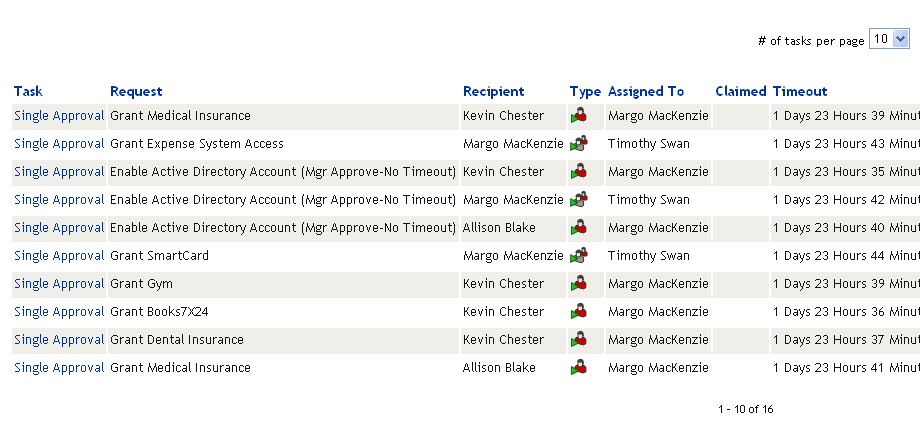
The template display lets you sort columns by value, set the number of tasks per page, and page through the task list.
Sorting a Column by Value
-
Click the heading of a column to sort the values in the column.
-
Click the heading again to reverse the order of the sort.
Setting the Number of Tasks per Page
-
Click the down-arrow of the selection box on the right side above the task list.
-
Choose a page length of 5, 10, or 25 tasks per page.
Paging Through the Task List
-
Click and to page through the task list.

The Exhibit Display Format
The Exhibit Display format enables you to filter your retrieved data. Figure 12-2 shows an example of the Exhibit Display format:
Figure 12-2 Example of Task List in Exhibit Display Format
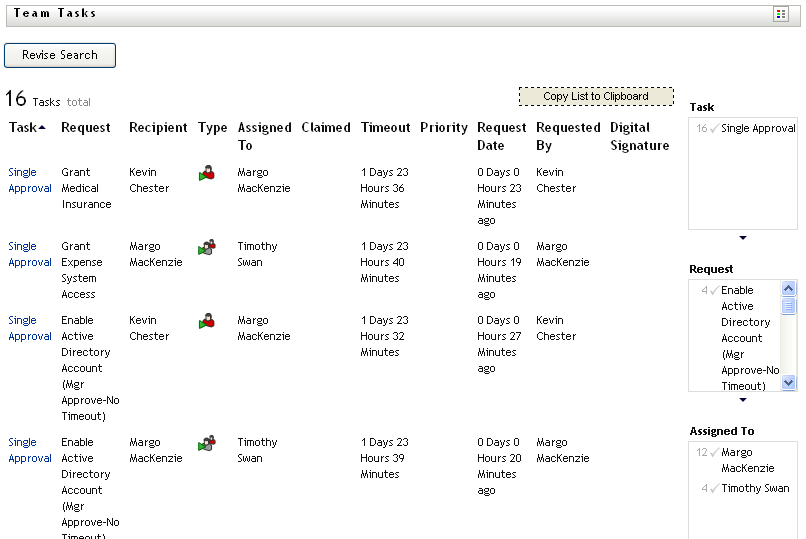
Sorting a Column by Value
-
Click the heading of a column to sort the values in the column.
-
Click the heading again to reverse the order of the sort.
Filtering Your View of the Data
The Exhibit Display format shows the whole data set returned by your search. You can use filters to filter the data set. The filters are on the right side of the display and have the names of column headings from your search. You can filter the data by and column values. Filters only appear if the corresponding columns are included in the display.
NOTE:The Exhibit Display refers to filters as facets.
Figure 12-3 shows an example with a Request filter and an Assigned To filter:
Figure 12-3 Two Filters in the Exhibit Display
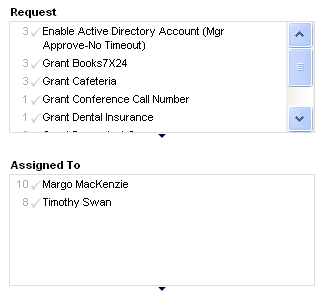
Beside each filter parameter is a number and optionally a check mark. The number indicates the number of tasks that match that parameter within the current filter set. The check mark indicates whether the filter parameter is selected. Initially, all filter parameters are selected, enabling you to see all the data from your search. If a filter has only one parameter, that parameter is automatically selected.
-
To view a subset of data, click one or more parameters in one or more filter boxes.
NOTE:Selecting a parameter in one filter can change the parameters available in other filters.
For example, if you click Margo’s name in the Assigned To filter and Kevin’s name in the Requested By filter, you see only tasks that are both assigned to Margo Mackenzie and requested by Kevin Chester, as shown in Figure 12-4:
Figure 12-4 Example of Task List After Applying Two Filters
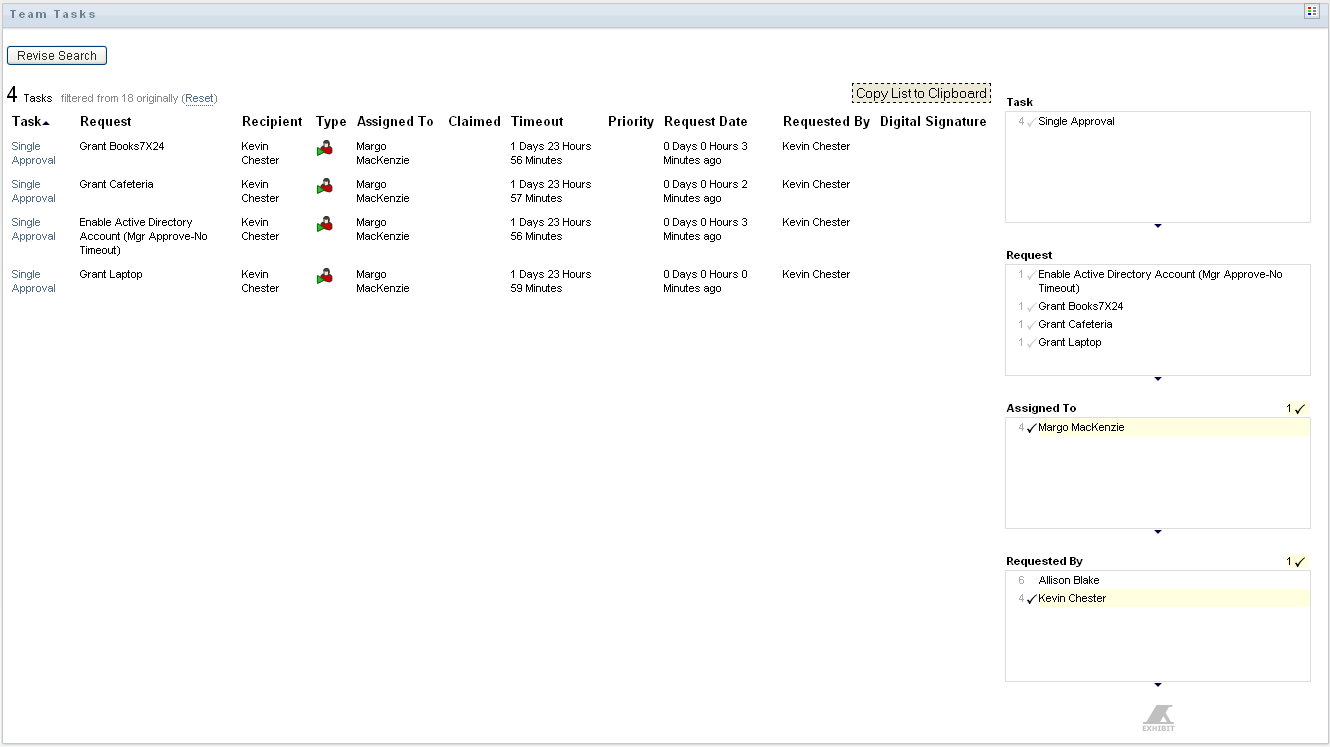
Exporting Data from Your Display
-
To export the data that you see in your display, click (at the top of the display).
-
Choose or . The Exhibit Display generates a coded text file.
-
Copy the contents to your clipboard.
-
Paste from your clipboard to a destination file.
-
Click or to close the window of coded text.
Understanding the Display Icons
The Template and Exhibit views both show icons that indicate the status of each task in the result set. This section describes the display icons that appear in the task list:
Type Column
Status flags appear under the column. Flags are defined in the Legend. To access the Legend, click the multicolored icon in the right side of the Team Tasks title bar. Figure 12-5 shows the Legend.
Figure 12-5 Icons that appear in the Team Tasks displays
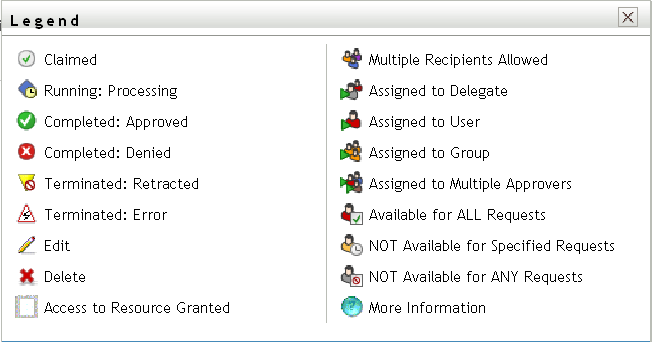
Priority Column
A red flag identifies a high-priority task. This priority is set in the Provisioning Request Definition created by your administrator.
Claimed Column
The
icon
![]() in the
column indicates that the task has been claimed.
in the
column indicates that the task has been claimed.
Digital Signature Column
The
icon
![]() in the
column indicates that a digital signature is required to approve or deny the task.
in the
column indicates that a digital signature is required to approve or deny the task.
12.2.4 Selecting a Task
To select and open a task in the task list:
-
Click the name of the task.
The Team Tasks Task Detail form is displayed.
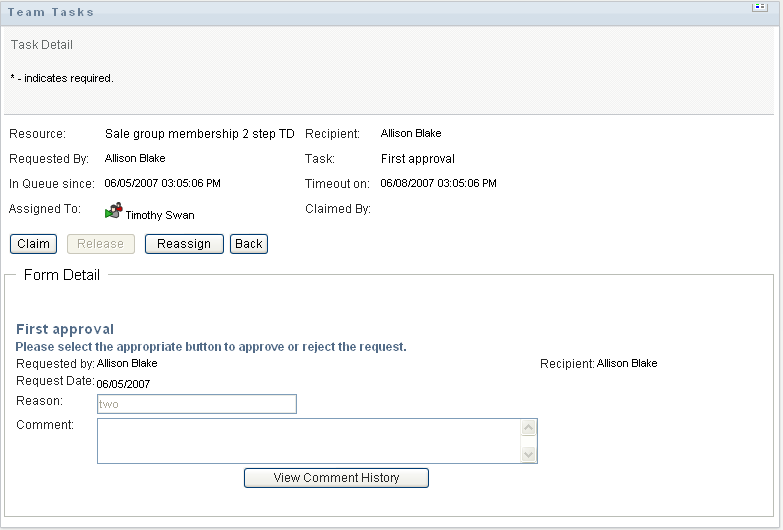
When a task is assigned to multiple approvers, the Task Detail form displays the icon next to the field, and displays text below the icon to indicate that multiple approvals are necessary.
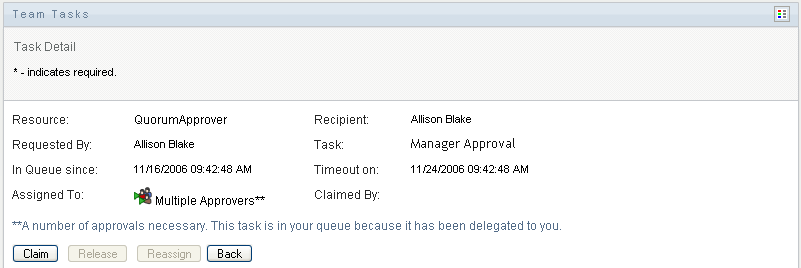
-
To display more information about a task assigned to multiple approvers, click the text under the icon:
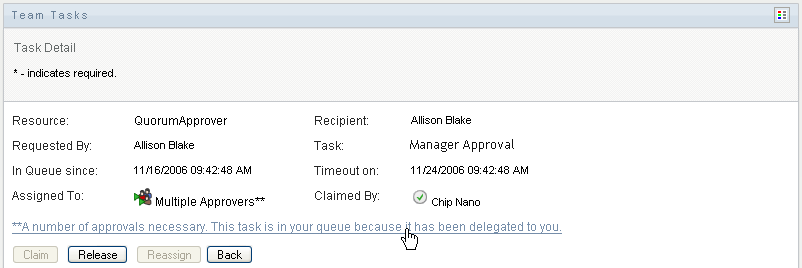
A pop-up window displays that indicates how many approvals are required, who the current addressees are, and what the approval status is currently.
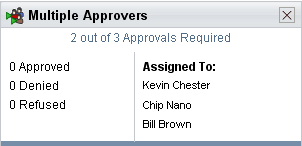
The requirements for the task depend on how the task was configured by your administrator:
-
If the approval type is group, the task has been assigned to several users within a group, but only one is expected to claim and approve the task.
-
If the approval type is multiple approvers, the task has been assigned to several addressees, and all of the addressees must claim and approve the task.
-
If the approval type is quorum, the task has been assigned to several addressees, and a quorum of addressees is sufficient to approve the task. The definition of a quorum is configured by the administrator. To define the quorum, the administrator specifies an approval condition that specifies the precise number of approvals or the percentage of approvals needed.
-
-
To claim a task, follow the instructions at Section 12.2.5, Claiming a Task.
-
To reassign a task, follow the instructions at Section 12.2.6, Reassigning a Task
-
To view comment history for the task, click .
A pop-up window lets you see user and system comments. The order in which comments appear is determined by the time stamp associated with each comment. Comments entered first are displayed first. For parallel approval flows, the order of activities being processed concurrently can be unpredictable.
-
To display user comments, click .
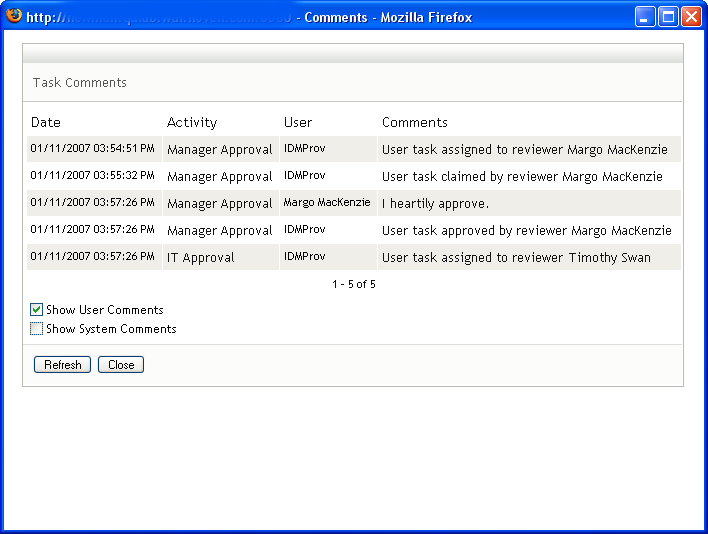
User comments include the following kinds of information:
-
The date and time when each comment was added.
-
The name of the activity to which each comment applies. The list of activities displayed includes user and provisioning activities that have been processed or are currently being processed.
-
The name of the user who made the comment. If the comment is generated by the workflow system, the name of the application (for example, IDMProv) is the user name. Comments generated by the workflow system are localized automatically.
-
The comment text, which includes the name of the user who is the current assignee for each activity.
NOTE:The workflow designer can disable the generation of user comments for a workflow. For more information, see the Identity Manager User Application: Design Guide.
-
-
To display system comments, click .
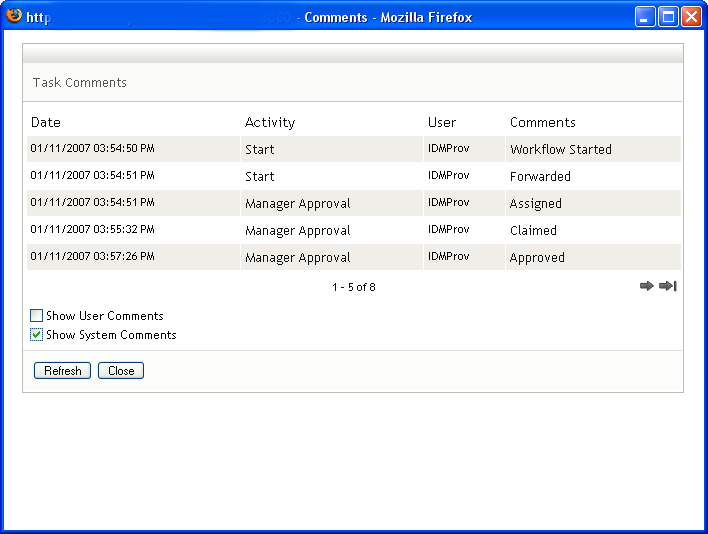
System comments include the following kinds of information:
-
The date and time when each comment was added.
-
The name of the activity to which each comment applies. When you display system comments, all activities in the workflow are listed. The list of activities includes those that have been processed or are currently being processed.
-
The name of the user who made the comment. If the comment is generated by the workflow system, the name of the application (for example, IDMProv) is the user name. Comments generated by the workflow system are localized automatically.
-
The comment text, which indicates what action was taken for the activity.
System comments are intended primarily for debugging purposes. Most business users do not need to look at the system comments for a workflow.
-
-
To scroll through a long list of comments, click the arrows at the bottom of the screen. For example, to scroll to the next page, click the arrow.

-
Click to close the window.
-
-
To return to the task list, click .
NOTE:The and buttons are visible only if these actions are permitted by the team request rights.
12.2.5 Claiming a Task
To claim a team member’s task to work on:
-
Click .
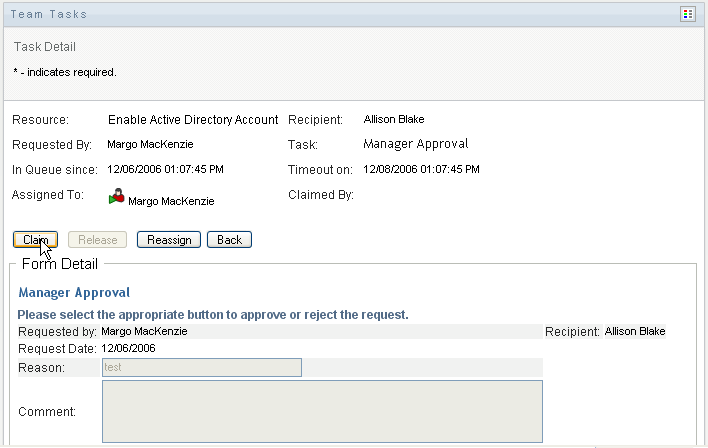
The section of the page is updated to include the and buttons, as well as any other action buttons included by the flow definition, and the appropriate fields become editable.
If the resource you’ve requested requires a digital signature, the Digital Signature Required icon appears in the upper right corner of the page.

In addition, on Internet Explorer, a message appears indicating that you need to press the Spacebar or the Enter key to activate the digital signature applet.

-
If you’re working on a task that requires a digital signature, perform these steps:
-
If you’re using a smart card, insert the smart card into the smart card reader.
-
On Internet Explorer, press the Spacebar or the Enter key to activate the applet.
At this point, your browser might display a security warning message.
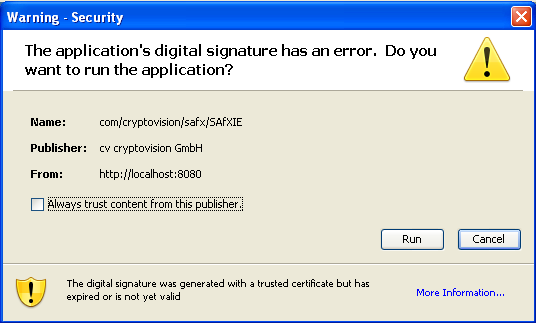
-
Click to proceed.
-
Fill in the fields in the approval form. The fields on the form vary depending on which resource you requested.
-
Click the check box next to the digital signature confirmation message to indicate that you are ready to sign.
The digital signature confirmation message varies depending on how the provisioning resource was configured by the administrator.
The applet then displays a pop-up window that allows you to select a certificate. The pop-up window lists certificates imported to the browser as well as certificates imported to the smart card (if one is currently connected).
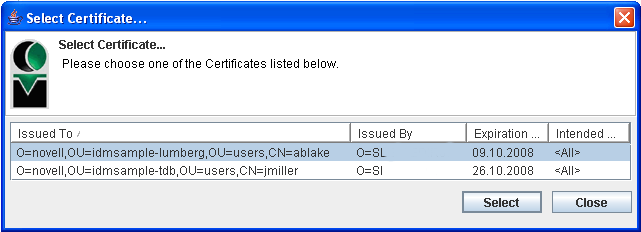
-
Select the certificate you want to use and click .
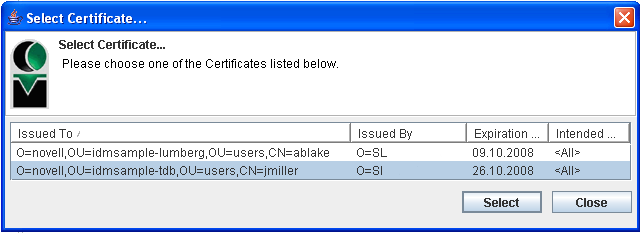
-
If you select a certificate that has been imported into your browser, you need to type the password for the certificate in the field on the request form.
-
If you select a certificate that has been imported to your smart card, type the PIN for your smart card and click .
You do not need to type the password for the certificate if you’re using a smart card, because the certificate password has already been transmitted to the card.
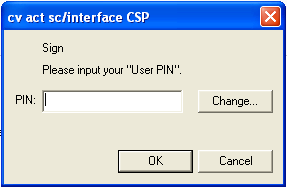
If your administrator has enabled the ability to preview the user agreement, the button is enabled.
-
Click to see the user agreement.
If the digital signature type is set to Form, a PDF document is displayed.
If the digital signature type is set to data, an XML document is displayed.
-
-
To deny the request, click .
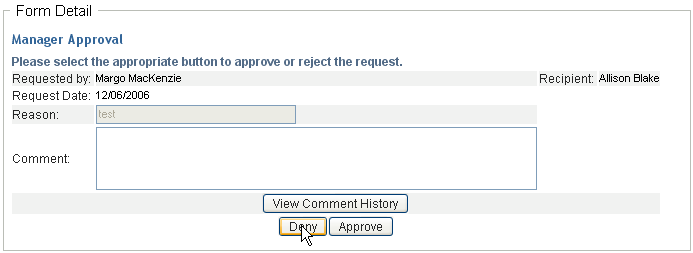
-
To approve the request, click .
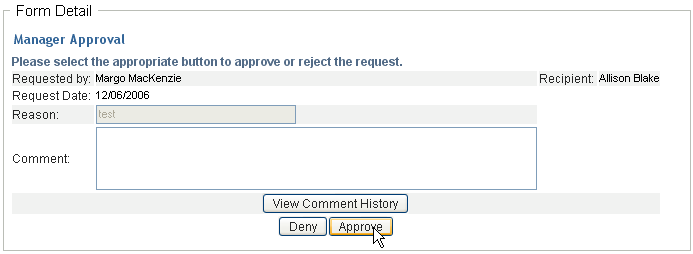
The user application displays a message indicating whether the action was successful.
12.2.6 Reassigning a Task
To reassign a team member’s task:
-
Click in the Team Tasks task detail window.
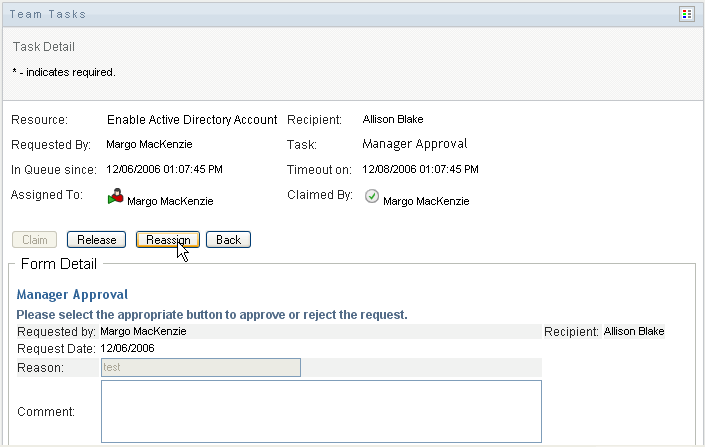
-
Click the icon
 next to your chosen entry box.
next to your chosen entry box.
-
In the drop-down list, select the user to whom you want to reassign the task.
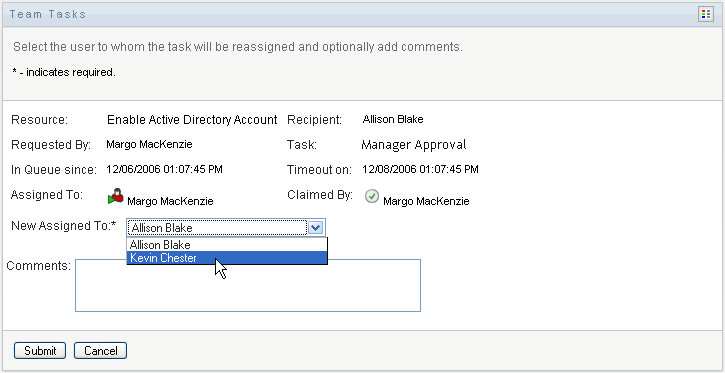
-
(Optional) Type a comment in the field to explain the reason for the reassignment.
-
Click .
The user application displays a message indicating whether the action was successful.
12.2.7 Releasing a Task
You release a task so that it can be assigned to or claimed by another team member.
-
Click in the Team Tasks Task Detail window.
